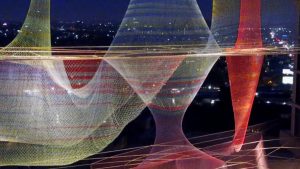Janet Echelman Looms Large
Description
Janet Echelman’s giant net sculptures are the result of an artistic process that encompasses technology, engineering, and civic engagement.
Featured Artists

Janet Echelman is an award-winning sculptor known for her large-scale fiber artworks.
Born in 1966 in Tampa, Florida, Echelman graduated from Harvard University and studied Chinese brush painting and calligraphy in Hong Kong. While living in India on a Fulbright scholarship, Echelman observed fishermen bundling their nets and was inspired to create elaborate fiber-based net-like sculptures.
She created her first monumental permanent outdoor sculpture in Porto, Portugal, in 2005. Using custom-built software and space-age materials, she has since created temporary and permanent works in Seattle, San Francisco, Vancouver, Denver, Phoenix, and elsewhere. Among her many awards, she received a Guggenheim Fellowship in Fine Arts (2011), Architectural Digest magazine’s Innovator award (2012), and an American Ingenuity Award from Smithsonian magazine (2014).
Transcript
Janet Echelman’s elaborate aerial net sculptures fuse ancient craft with modern technology to create massive works that are strong enough to withstand a hurricane, but soft enough to draw city dwellers into unexpected moments of tranquility.
Janet Echelman: We are in need of the experience of softness in our lives. I want to be in a city and feel a soft billowing presence above my head. We are building our world with hard edges and hard materials and glass and steel and concrete, and I love those materials. They become a foil. It’s like counterpoint in music. One becomes more soft because the other is so hard.
I use five different fibers and I use them differently. When a spider weaves a web, it doesn’t have the same silk in the different parts of the web. They use a structural silk for the parts that come out from the center, and the circular parts are very light and sticky silk. And so, in the same way, the parts of my sculpture that are pulled taut and carry the structural load are made of a very strong fiber. It’s stronger than steel—15 times stronger than steel. I braid a core of the strong fiber, and then I braid a sleeve of the protective layer from the sun so that I can have the best of the function of each material.
But she doesn’t do it alone. To manifest these grand ideas, Echelman depends on the skills of a team of designers and engineers. In addition, it took the giant software company Autodesk three years to develop the program now used at Studio Echelman. The modeling tool allows them to forecast how a sculpture will interact with gravity, wind, and the city’s surrounding architecture.
Echelman: We wanted to build sculptures at the scale of cities and you can’t do that with hand models. I’m an artist who wants to see things happen and the tools don’t exist, so I realized I’ll either be limited or I have to make my own tools.
It all began in 1997 when Echelman was awarded a Fulbright to make art in Mahabalipuram, an Indian fishing village renowned for its sculpture. Though she was to give painting demonstrations in the community, her supplies never arrived from the U.S. Then one evening, watching local fisherman bundle their nets, she discovered the material that would become the genesis of her public art. But ideas that would become monumental in scale began at the microscopic level.
Echelman: I learned about these early lifeforms that were all one cell thick—the Precambrian era—and with that constraint of design, there were this incredible variety of forms. And that was the constraint I set for myself in my first sculpture. What can you do when you’re just surface area?
Janet Echelman has always been a dreamer. Her latest piece, 2017’s Dream Catcher, was built as the connecting tissue between two new Los Angeles hotels.
Echelman: The Dream Catchers are on four levels and then it’s the first time I’m doing multiple forms pulling between them. And it’s this interplay because it’s on the Sunset Strip in West Hollywood, where everyone goes to capture their dream. But what really became the inspiration was looking at the monitoring of brain waves. And suddenly, when you reach that deep sleep, REM sleep, they go crazy! It’s not one color. It’s always changing, just as our thoughts are. Just as our brain waves are.
Janet Echelman was always set on becoming an artist, though at the outset it wasn’t clear what that would mean.
Echelman: It’s not like I planned this. I knew I wanted to be an artist, and I think it would feel like dying if I couldn’t. So, it makes the choice really easy. There were times when I wanted to make work but nobody wanted to see it. And now I have the problem that we get so many calls and I have to figure out which projects to take. Really, I respond to interesting design challenges and interesting invitations to make art.
When she does accept an invitation, it can take years of planning and millions of dollars to bring it to fruition. And when it does all finally come together, Echelman says her greatest joy is in experiencing the work first hand.
Echelman: The reason I’m doing this is because I care about art being part of life. I don’t want it to be shut away inside a box where only certain people feel entitled to go there. It should just infuse our everyday—when you’re walking to work, on your lunch break. Some of the peak moments of my life are lying down under the work and discovering the sky breathing, you know, as the piece moved. It slows down the patterns and eddies of wind. I think I build these things because I want to lie down underneath them.

